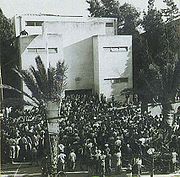
Carl Rubin (architect)
Encyclopedia

International style (architecture)
The International style is a major architectural style that emerged in the 1920s and 1930s, the formative decades of Modern architecture. The term originated from the name of a book by Henry-Russell Hitchcock and Philip Johnson, The International Style...
with projects focused around Tel Aviv
Tel Aviv
Tel Aviv , officially Tel Aviv-Yafo , is the second most populous city in Israel, with a population of 404,400 on a land area of . The city is located on the Israeli Mediterranean coastline in west-central Israel. It is the largest and most populous city in the metropolitan area of Gush Dan, with...
.
Biography
Carl Rubin was born in 1899 in Galicia, and studied architecture in ViennaVienna
Vienna is the capital and largest city of the Republic of Austria and one of the nine states of Austria. Vienna is Austria's primary city, with a population of about 1.723 million , and is by far the largest city in Austria, as well as its cultural, economic, and political centre...
. In 1920, Rubin decided to move to Eretz Israel and settle in Tel Aviv for some time. During his stay, Rubin planned gardens, residential and public buildings. In 1931, Rubin began working as an apprentice in the office of Erich Mendelsohn
Erich Mendelsohn
Erich Mendelsohn was a Jewish German architect, known for his expressionist architecture in the 1920s, as well as for developing a dynamic functionalism in his projects for department stores and cinemas.-Early life:...
, a Jewish architect at that time working in Berlin
Berlin
Berlin is the capital city of Germany and is one of the 16 states of Germany. With a population of 3.45 million people, Berlin is Germany's largest city. It is the second most populous city proper and the seventh most populous urban area in the European Union...
. The influence of the original style of Mendelsohn would later be evident in Rubin's projects.
In 1932, Rubin decided to return to the country and settled again in Tel Aviv. In this second period in the country Rubin opened his own architectural office. Rubin was a prominent Jewish architect, with a prolific career. Carl Rubin is an example from Erich Mendelsohn's circle (in addition to those from the Bauhaus
Bauhaus
', commonly known simply as Bauhaus, was a school in Germany that combined crafts and the fine arts, and was famous for the approach to design that it publicized and taught. It operated from 1919 to 1933. At that time the German term stood for "School of Building".The Bauhaus school was founded by...
, and the circle of Le Corbusier
Le Corbusier
Charles-Édouard Jeanneret, better known as Le Corbusier , was a Swiss-born French architect, designer, urbanist, writer and painter, famous for being one of the pioneers of what now is called modern architecture. He was born in Switzerland and became a French citizen in 1930...
) important in contributing to the development of Tel Aviv towards the UNESCO
UNESCO
The United Nations Educational, Scientific and Cultural Organization is a specialized agency of the United Nations...
recognition of the "White City" as a World Heritage Site
World Heritage Site
A UNESCO World Heritage Site is a place that is listed by the UNESCO as of special cultural or physical significance...
.
Projects
Rubin designed numerous residential complexes in Tel Aviv, one such building dated 1932 at Rothschild Boulevard 85, sold for 7 million dollars.One of Rubin's important design accomplishments was his remodeling of what would become Israel's Independence Hall (at Rothschild Boulevard
Rothschild Boulevard
Rothschild Boulevard is one of the principal streets in the center of Tel Aviv, Israel, beginning in Neve Tzedek at its southwestern edge and running north to Habima Theatre. It is one of the busiest and most expensive streets in the city, being one of the city's main tourist attractions...
16) when in 1932 Mayor of Tel Aviv Meir Dizengoff
Meir Dizengoff
Meir Dizengoff was a Zionist politician and the first mayor of Tel Aviv.-Biography:Meir Dizengoff was born in 1861 in the village of Akimovici near Orgeyev, Bessarabia. In 1878, his family moved to Kishinev, where he graduated from high school and studied at the polytechnic school...
donated his house to become the first home of the Tel Aviv Museum of Art
Tel Aviv Museum of Art
The Tel Aviv Museum of Art is an art museum in Tel Aviv, Israel. It was established in 1932 in a building that was the home of Tel Aviv's first mayor, Meir Dizengoff. The Helena Rubinstein Pavilion for Contemporary Art opened in 1959. The museum moved to its current location on King Saul Avenue in...
. Rubin made the plan and elevations symmetrical, and removed the architectural ornament. His modifications characterised the appearance of the building from its time beginning as the art museum to the time of the declaration to the present.Tel Aviv In Focus, Dizengoff House accessed 14 September 2009
From 1935-1936, Rubin was the architect of the office building Beit Hadar, the first in Tel Aviv with a steel frame
Steel frame
Steel frame usually refers to a building technique with a "skeleton frame" of vertical steel columns and horizontal -beams, constructed in a rectangular grid to support the floors, roof and walls of a building which are all attached to the frame...
structure.

